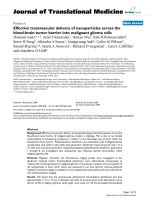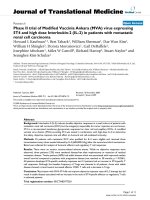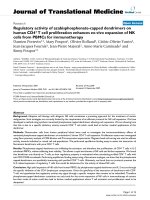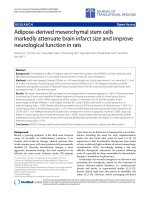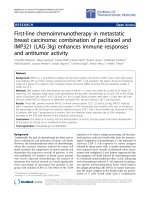Báo cáo hóa học: " Complications post renal transplantation: literature focus on BK virus nephropathy and diagnostic tools actually available" doc
Bạn đang xem bản rút gọn của tài liệu. Xem và tải ngay bản đầy đủ của tài liệu tại đây (566.84 KB, 6 trang )
BioMed Central
Page 1 of 6
(page number not for citation purposes)
Virology Journal
Open Access
Review
Complications post renal transplantation: literature focus on BK
virus nephropathy and diagnostic tools actually available
Monica Mischitelli
1
, Anna Bellizzi
1
, Elena Anzivino
1
, Daniela Fioriti
1
,
Renzo Boldorini
2
, Umberto Miglio
2
, Fernanda Chiarini
1
, Franco Di Monaco
3
and Valeria Pietropaolo*
1
Address:
1
Department of Public Health Sciences, "La Sapienza" University, Rome, Italy,
2
Department of Medical Sciences, Faculty of Medicine,
University Amedeo Avogadro of East Piedmont, Novara, Italy and
3
Department of Urology, "La Sapienza" University, Rome, Italy
Email: Monica Mischitelli - ; Anna Bellizzi - ;
Elena Anzivino - ; Daniela Fioriti - ; Renzo Boldorini - ;
Umberto Miglio - ; Fernanda Chiarini - ; Franco Di
Monaco - ; Valeria Pietropaolo* -
* Corresponding author
Abstract
Clinical diagnosis of kidney transplants related illnesses is not a simple task. Several studies were
conducted to define diseases and complications after renal transplantation, but there are no
comprehensive guidelines about diagnostic tools for their prevention and detection.
The Authors of this review looked for the medical literature and pertinent publications in particular
to understand the role of Human Polyomavirus BK (BKV) in renal failure and to recognize analytical
techniques for BK virus associated nephropathy (BKVAN) detection.
Introduction
Clinical diagnosis of kidney transplants related illnesses is
not a simple task. Several studies were conducted to define
diseases and complications after renal transplantation,
but there are no comprehensive guidelines about diagnos-
tic tools for their prevention and detection.
The Authors of this review looked for the medical litera-
ture and pertinent publications in particular to under-
stand the role of Human Polyomavirus BK (BKV) in renal
failure and to recognize analytical techniques for BK virus
associated nephropathy (BKVAN) detection. For review-
ing we used Medline and recent pertinent bibliographies.
Kidney pathologies in renal transplants are associated
with graft function, immunosuppressive drugs and infec-
tions [1]. Moreover cardiovascular, bone and bone mar-
row diseases, metabolism dysfunctions and cancers could
affect these patients [2,3]. Graft function is the most
important parameter in evaluation of the allograft status;
acute rejection, obstruction, renal artery stenosis could
influence renal function resulting in graft dysfunctions
and ultimately in chronic renal allograft failure [1,4,5].
Persistent urinary protein excretion and hyperlipidemia
are associated with acute rejection, in particular heavy
proteinuria has important consequences for extracellular
fluid volume regulation and demonstrate the rapid deteri-
oration of renal function associated with pathologic
glomerular lesions [6,7]. Serum creatinine levels and
urine protein/creatinine ratio (total protein excretion)
should be used to screen for changes in renal function.
Acute allograft rejection could be also due to interstitial
Published: 3 March 2008
Virology Journal 2008, 5:38 doi:10.1186/1743-422X-5-38
Received: 14 February 2008
Accepted: 3 March 2008
This article is available from: />© 2008 Mischitelli et al; licensee BioMed Central Ltd.
This is an Open Access article distributed under the terms of the Creative Commons Attribution License ( />),
which permits unrestricted use, distribution, and reproduction in any medium, provided the original work is properly cited.
Virology Journal 2008, 5:38 />Page 2 of 6
(page number not for citation purposes)
infiltrates and mild tubulitis that unfortunately are clini-
cally silent and could be detected only by immunohisto-
chemistry (IHC) [1].
Immunosuppression therapy
The morbidity and mortality rates associated with renal
transplantation and the use of immunosuppressive medi-
cations are high. Conventional immunosuppression is
based on azathioprine, nevertheless, other immunosup-
pressive drugs, such as cyclosporine A (CsA), tacrolimus,
sirolimus, mycophenolate-mofetil (MMF) and corticos-
teroids are used [1,8]. To reduce adverse effects of immu-
nosuppressive therapies, it is strongly recommended to
monitor routinely blood level of CsA, tacrolimus and
sirolimus. The nephrotoxicity associated with azathio-
prine and MMF is monitored by assessing hemoglobin
levels, hematocrit value and white blood cell counts at
least weekly for months 1 to 2, every 2 week for months 3
to 4, monthly for months 4 to 12, and then every 3 to 6
months [1,8-12]. Finally toxicity related to corticosteroids
is monitored periodically by controlling blood pressure,
lipoprotein levels and blood glucose levels [8,11]. Com-
pared with conventional immunosuppression with aza-
thioprine, CsA reduced the incidence of acute rejection
and prolonged graft survival but caused chronic tubu-
lointerstitial atrophy and fibrosis that are difficult to dis-
tinguish from chronic allograft nephropathy attributable
to other causes [1,13]. Instead the role of acute and
chronic tacrolimus nephrotoxicity in graft failure is
unclear. However the incidence of renal toxicity is roughly
proportional to tacrolimus doses and its blood levels [14].
In the other hand sirolimus seems to be efficacious in pre-
venting acute rejection when used in place of, or in com-
bination with, CsA. However very few studies have been
conducted to determine the relationship between blood
levels of sirolimus and either acute rejection or toxicity
[10]. Regarding azathioprine and MMF, hematologic and
gastrointestinal toxicities are usually dose-related and
respond to dose reductions [12]. Moreover MMF causes
leukopenia in renal transplants. Finally clinical signs of
corticosteroid toxicity, which are observed relatively soon
after the initiation of prednisone treatment, include skin
changes, hypertension, peptic ulcer disease and myopathy
[8].
Human Poliomavirus BK and BKVAN
Viral infections cause several complications in renal trans-
plants that are closely related with the immunosuppres-
sive therapy. On the basis of literature data, viruses
implicated in graft failure we could number Varicella
zoster, Cytomegalovirus, Influenza A and B, Hepatitis B
and C and human Poliomavirus BK and JC [15-18]. In
particular BK virus, described for the first time in a trans-
plant recipient, has a remarkable tropism for the geni-
tourinary tract, in fact BKVAN are recognized as an
important cause of late allograft failure [19].
BKV is ubiquitous in human populations worldwide. BKV
infects young children and the seroprevalence is 70%–
80% in adults [20,21]. Serologic surveys of populations,
using hemagglutination inhibition assay for the detection
of antibodies, indicate that seroconversion takes place
early in life, at 5–7 years of age [20,21]. Primary infection
is usually inapparent and only occasionally may be
accompanied by mild respiratory illness or urinary tract
disease. During primary infection viremia occurs and the
virus spreads to several organs of the infected individual
where it remains in a latent state. After the initial infec-
tion, the virus disseminates and establishes a persistent
infection in the urinary tract and maybe in lymphocytes
[20,22,23].
The complete genome of BKV contains 5,153 bp and it is
functionally divided into three regions: the early, the late,
and the transcriptional control region (TCR). The first
region codes for the small and large T-antigens (t-Ag and
T-Ag), the second region codes for the viral capsid pro-
teins VP1-VP2-VP3 and agno-protein, and the last region
(TCR) contains the transcriptional control elements for
both "early" and "late" gene expression [24] Primary tran-
scripts are required for viral replication, in particular T-Ag
promotes unwinding of the double helix and recruitment
of cellular proteins required for DNA synthesis whereas in
non permissive cells it is involved in neoplastic transfor-
mation [24,25] (Fig. 1). Late transcripts encode for viral
capside proteins and agnoprotein, that has a critical role
in the regulation of viral gene expression and replication,
and in the modulation of certain important host cell func-
tions including cell cycle progression and DNA repair
[26]. TCR contains the origin of replication and it is arbi-
trarily divided into four box alphabetically designated P,
Q, R and S. These sequence blocks serve as regulatory
regions, or enhancer elements believed to contain several
transcription factor binding sites involved in the modula-
tion of viral transcription [24,27,28]. It is not known that
genetic alterations are essential for the pathogenesis asso-
ciated with BKV after kidney transplantation, nevertheless
BK-strains with rearranged TCR have been particularly
described in subjects under immunosuppressive therapies
[24,29,30]. In renal transplants BKV infection may be
transmitted via the donor organ, may be acquired in the
community or latent BKV could reactivate [31,32]. The
incidence of allograft failure has ranged from 15 to 50%
in affected individuals [33], but few data are available
about BKVAN; it probably due to recent emerging of this
disease as an important cause of allograft failure following
renal transplantation. BKV urinary shedding of infected
urothelial cells occurs in 10 to 60% of renal transplant
recipients [34] and literature data suggest that prospective
Virology Journal 2008, 5:38 />Page 3 of 6
(page number not for citation purposes)
monitoring of patients at risk for BKVAN may identify
those with active infection before renal function deterio-
rates [35-37]. Recent studies demonstrated that BKVAN
develop in as many as 8% of renal allograft recipients,
with as many as 50% of patients experiencing graft loss
over the next 2 to 3 years of follow-up [34,38,39]. A cur-
rent study performed by Giraldi et colleagues show that,
in a cohort of the 117 patients followed up every three
months during a two year period after transplantation, 4
had BKVAN (3.4%) confirmed by quantitative assays on
plasma and urine and assessed by allograft biopsy [40].
BKVAN diagnosis
BKVAN diagnosis is very difficult since this disease is often
misdiagnosed as acute rejection or drug toxicity. Diagnos-
tic tools available include histopathology by means of
renal allograft biopsy, detection of BKV DNA on plasma
and urine by polymerase-chain-reaction (PCR) and quan-
titative PCR (QPCR) and presence of "decoy cells" in the
urine sediment. Diagnostic confirmation may be
obtained using IHC, in situ hybridization (ISH), and/or
electron microscopy (EM) in renal biopsy specimens
[34,41-45].
Early identification provides the opportunity for interven-
tion with reduction of the immunosuppression in an
effort to control BKV replication and prevent BKVAN. The
risk factors predisposing to BKVAN appear to be multiple,
with immunosuppressive regimens containing tacrolimus
and MMF representing recognized associations [41,46].
Several investigators have begun to define risk factors for
BKV disease among renal transplant recipients. The sero-
logic status of the donor and the recipient appears to be a
predictor of BKV infection, but it is not currently clear
whether it influences the development of BKV nephritis.
Tubular injury could be a factor promoting viral replica-
tion in an immunocompromised state induced by tac-
rolimus or MMF. The load of dormant BKV in the grafted
organ is likely to be another important risk factor: no dor-
mant virus, no re-activation and most likely, no BKVAN
[47]. On these basis, since no specific anti-viral therapy is
available, reduction in immunosuppression remains the
mainstay of treatment with an increased risk of subse-
quent rejection. Therefore an accurate diagnosis is impor-
tant, as it allows for early intervention and possible
recovery of renal function.
Urine cytology is based on decoy cells recovery. Decoy
cells are epithelial cells with enlarged nuclei and large
basophilic ground-glass intranuclear viral inclusions,
screening for their presence provides a simple and an inex-
pensive tool for the diagnosis of BKV nephropathy, never-
theless, Papanicolaou-stained urine sediment is not to be
considered a specific morphological marker of BKV dis-
ease [48,49].
Electron microscopy is very sensitive for detection of BK
virions, but the finding of viral particles is not diagnostic
of BKVAN, since the ultrastructural appearance of BK virus
is poorly typical. Virions are arranged in paracrystalline
arrays of naked, round, electron-dense structures that
measure 45 nm in diameter. It is important to emphasize
that electron microscopy cannot distinguish BKV from JC
virus [41] (Fig. 2).
The histological diagnosis of BKVAN requires evaluation
of a renal biopsy with demonstration and confirmation of
the polyomavirus cytopathic changes by IHC and ISH
[41]. BKVAN is characterized by the presence of polyoma-
virus cytopathic changes in the epithelium of the renal
tubules and urothelial lining. The infected cells have an
enlarged nucleus with a gelatinous basophilic inclusion
resulting from the accumulation of the newly formed vir-
ions [50]. Confirmation of the polyomavirus infection is
usually performed with immunohistochemical stains for
the simian virus 40 (SV40) large T antigen (AgT), which
identifies all polyomavirus infections due to cross-reactiv-
ity between SV40 and both BKV and JCV. Distinction
between the different types of polyomavirus requires the
use of species-specific antibodies, ISH or in situ PCR. Sys-
tematic studies comparing the clinical utility of each
method have not been performed [50]. The sections are
Schematic representation of the gene organization in the BK virus (BKV) genomeFigure 1
Schematic representation of the gene organization in the BK
virus (BKV) genome. The double circle represents the dou-
ble stranded DNA genomes. The genome is divided into
three regions. The early region encodes three regulatory
proteins (Agt, AgT, T'). The late region specifies four struc-
tural proteins and agnoprotein (VP1, VP2, VP3, VPx). The
non-coding control region contains the elements for the con-
trol of viral DNA replication (ori) and viral gene expression.
The arrows indicate the positive and negative strands
according to the direction of viral transcription (24).
Virology Journal 2008, 5:38 />Page 4 of 6
(page number not for citation purposes)
stained with hematoxylin-eosin and examined by means
of light microscopy in order to evaluate the integrity of the
tissue before proceeding to molecular analysis, to identify
possible pathologic changes, and in particular to search
for the presence of morphologic equivalents of cellular
polyomavirus infection. In situ hybridization and immu-
nohistochemistry are carried out to define the viral status
of the infected tissues The reactions are detected by means
of the streptavidin-biotin method and are revealed using
diaminobenzidine as a chromogen. In situ hybridization
is performed to localize the nucleic acid sequences of BKV
and JCV at the subcellular level using commercially avail-
able biotinylated DNA probes [51].
For efficient early diagnosis of BKVAN, various molecular
approaches are recommended. Quantitative PCR is a non-
invasive method clinically useful since it is high sensitive
and specific and it supplies quantitative data that allow
pharmacological therapy management by clinicians
because specific antiviral therapy for BKVAN does not cur-
rently exist and the reduction in immunosuppression
depend on viral loads in urine and plasma specimens of
kidney transplants [32,33,36,52]. Nevertheless it is
important to underlie that the relationship between BKV
viruria and viremia, the cut-offs and predictive values of
BKV viruria and viremia for the occurrence of BKVAN, are
still largely undefined [33]. In fact some literature studies
from 2004 to nowadays showed that measurements of
BKV viruria and BKV viremia have a different prognostic
value for patient's therapeutic response and duration of
therapy. In accordance with Drachenberg et colleagues
BKV viruria precedes BKV viremia and it is a prerequisite
for histologically proven BKVAN because the viral replica-
tion within the graft finally leads from viruria to viremia
[53]. This hypothesis is also sustained by other Authors
that maintained that viremia is not present in patients
with low-level/limited viral replication in the urinary tract
[34,43,44,52,54]. Moreover, in relation to these Authors,
viremia is not useful for screening because of blood inhib-
itors present in plasma sample. Finally, although analyti-
cal and physiological variations may be significant when
comparing viral urine load in patients with BKVAN, there
is general agreement that repeated values above 10
7
BKV
copies per milliliter are associated with BKVAN [32,53].
On the other hand a recent study performed by Basse et
collaborators suggested that BKV viremia is a rare event
after renal transplantation but it has emerged as the most
specific test for BKV associated nephropathy [55]. Some
Authors retain BKV viremia as the standard for BKVAN
diagnosis since the presence of the virus in the blood rep-
resents a significant tissue damage and confirm the renal
parenchymal involvement [37,56]. Therefore serial deter-
minations of BK viremia are the best tool to demonstrate
resolution of the disease after immunosuppression has
been decreased [37,55-58]. Nevertheless, a study carried
out by Hymes et colleagues from June 2003 to January
2006 on 20 renal transplant children showed that most
patients remained PCR-positive despite reduction of
immunosuppression. Moreover they did not identify any
one drug as more prevalent among patients with BK
viremia [59].
Conclusion
In conclusion, there are several aspects of BKVAN pathol-
ogy in kidney transplant patients requiring evaluation; it
includes BKV transmissibility within kidneys trans-
planted, target organ effects, risk factors, time frame of
reactivation and the best treatment options. Therefore it is
essential to understand and to monitor the delicate bal-
ance between viral infection, immune regulation in the
transplant population and immunosuppressive therapy
in order to minimize viral injury and rejection risk to
patients with BKV infection. Measuring of BKV DNA in
urine and serum is an useful and non invasive tool for
early detection and monitoring, nevertheless a combined
approach of molecular techniques must be utilized to
identify BK virus-associated nephropathy at an early phase
facilitating well timed clinical intervention.
Immunohistochemistry, peroxidase stain, diaminobenzidine as marker, staining for BK polyoma virus with the antibody targeting the SV40 antigenFigure 2
Immunohistochemistry, peroxidase stain, diaminobenzidine
as marker, staining for BK polyoma virus with the antibody
targeting the SV40 antigen. Note easily detectable, strong
nuclear immunoreactivity in tubular cells. (350×), (41).
Virology Journal 2008, 5:38 />Page 5 of 6
(page number not for citation purposes)
References
1. Kasiske BL, Vazquez MA, Harmon WE, Brown RS, Danovitch GM,
Gaston RS, Roth D, Scandling JD, Singer GG, for the American Soci-
ety of Transplantation: Recommendations for the outpatient
surveillance of renal transplant recipients. J Am Soc Nephrol
2000, 11:S1-S86.
2. Jeloka TK, Ross H, Smith R, Huang M, Fenton S, Cattran D, Schiff J,
Cardella C, Cole E: Renal transplant outcome in high-cardio-
vascular risk recipients. Clin Transplant 2007, 21:609-614.
3. Matignon M, Dahan K, Fruchaud G, Audard V, Grimbert P, Lang P:
Kidney transplantation: indications, results, limitations, and
perspectives. Presse Med 2007, 36:1829-1834.
4. Foster CE, Weng RR, Smith CV, Imagawa DK: The influence of
organ acceptance criteria on long-term graft survival: out-
comes of a kidney transplant program. Am J Surg 2007,
195:149-152.
5. Johnston O, O'kelly P, Spencer S, John Donohoe, Walshe JJ, Little
DM, Hickey D, Conlon PJ: Reduced graft function (with or with-
out dialysis) vs immediate graft function–a comparison of
long-term renal allograft survival. Nephrol Dial Transplant 2006,
21:2270-2274.
6. Sancho A, Gavela E, Avila A, Morales A, Fernández-Nájera JE, Crespo
JF, Pallardo LM: Risk factors and prognosis for proteinuria in
renal transplant recipients. Transplant Proc 2007, 39:2145-2147.
7. Schaub S, Mayr M, Hönger G, Bestland J, Steiger J, Regeniter A, Mihat-
sch MJ, Wilkins JA, Rush D, Nickerson P: Detection of subclinical
tubular injury after renal transplantation: comparison of
urine protein analysis with allograft histopathology. Trans-
plantation 2007, 84:104-112.
8. Braun WE: Renal transplantation: basic concepts and evolu-
tion of therapy. J Clin Apher 2003, 18:141-152.
9. Böhmig GA, Regele H, Hörl WH: Protocol biopsies after kidney
transplantation. Transpl Int 2005, 18:131-139.
10. Goldsmith D, Al-Khoury S, Shah N, Covic A: Anaemia after renal
transplantation–role of immunosuppressive drugs and a
pathophysiological appraisal. Nephron Clin Pract 2006, 104:69-74.
11. Goldfarb S: Update in nephrology. Ann Intern Med 2008,
148:49-54.
12. Shipkova M, Armstrong VW, Oellerich M, Wieland E: Mycopheno-
late mofetil in organ transplantation: focus on metabolism,
safety and tolerability. Expert Opin Drug Metab Toxicol 2005,
1:505-526.
13. Vítko S, Viklický O: Cyclosporine renal dysfunction. Transplant
Proc 2004, 36:243S-247S.
14. Scott LJ, McKeage K, Keam SJ, Plosker GL: Tacrolimus: a further
update of its use in the management of organ transplanta-
tion. Drugs 2003, 63:1247-1297.
15. Drachenberg CB, Hirsch HH, Papadimitriou JC, Gosert R, Wali RK,
Munivenkatappa R, Nogueira J, Cangro CB, Haririan A, Mendley S,
Ramos E: Polyomavirus BK versus JC replication and neph-
ropathy in renal transplant recipients: a prospective evalua-
tion. Transplantation 2007, 84:323-330.
16. Fishman JA, Emery V, Freeman R, Pascual M, Rostaing L, Schlitt HJ,
Sgarabotto D, Torre-Cisneros J, Uknis ME: Cytomegalovirus in
transplantation-challenging the status quo. Clin Transplant
2007, 21:149-158.
17. Linares L, Cofán F, Cervera C, Ricart MJ, Oppenheimer F, Campistol
JM, Moreno A: Infection-related mortality in a large cohort of
renal transplant recipients. Transplant Proc 2007, 39:2225-2227.
18. Schweitzer EJ, Perencevich EN, Philosophe B, Bartlett ST: Estimated
benefits of transplantation of kidneys from donors at
increased risk for HIV or hepatitis C infection. Am J Transplant
2007, 7:1515-1525.
19. Randhawa P, Vats A, Shapiro R: The pathobiology of polyomavi-
rus infection in man. Adv Exp Med Biol 2006, 577:148-159.
20. Knowles WA: Discovery and epidemiology of the human poly-
omaviruses BK virus (BKV) and JC virus (JCV). Adv Exp Med
Biol 2006, 577:19-45.
21. Lundstig A, Dillner J: Serological diagnosis of human polyoma-
virus infection. Adv Exp Med Biol 2006, 577:96-101.
22. Ashok A, Atwood WJ: Virus receptors and tropism. Adv Exp Med
Biol 2006, 577:60-72.
23. Doerries K: Human polyomavirus JC and BK persistent infec-
tion. Adv Exp Med Biol 2006, 577:102-116.
24. Fioriti D, Videtta M, Mischitelli M, Degener AM, Russo G, Giordano
A, Pietropaolo V: The human polyomavirus BK: Potential role
in cancer. J Cell Physiol 2005, 204:402-406.
25. Lee W, Langhoff E: Polyomavirus in human cancer develop-
ment. Adv Exp Med Biol 2006, 577:310-318.
26. Khalili K, White MK, Sawa H, Nagashima K, Safak M: The agnopro-
tein of polyomaviruses: a multifunctional auxiliary protein. J
Cell Physiol 2005, 204:1-7.
27. Hirsch HH, Steiger J: Polyomavirus BK. Lancet Infect Dis 2003,
3:611-623.
28. Kim HS, Henson JW, Frisque RJ: Transcription and replication in
the human polyomaviruses. In Human Polyomaviruses Edited by:
Wiley-Liss. INC. New York; 2001:73-126.
29. Agha I, Brennan DC: BK virus and immunosuppressive agents.
Adv Exp Med Biol 2006, 577:174-184.
30. Randhawa P, Zygmunt D, Shapiro R, Vats A, Weck K, Swalsky P, Fin-
kelstein S: Viral regulatory region sequence variations in kid-
ney tissue obtained from patients with BK virus
nephropathy. Kidney Int 2003, 64:743-747.
31. Hariharan S: BK virus nephritis after renal transplantation. Kid-
ney Int 2006, 69:655-662.
32. Hirsch HH: BK virus: opportunity makes a pathogen. Clin Infect
Dis 2005, 41:354-360.
33. Djamali A, Samaniego M, Muth B: Medical care of kidney trans-
plant recipients after the first posttransplant year. Clin J Am
Soc Nephrol 2006, 1:623-640.
34. Pang XL, Doucette K, LeBlanc B, Cockfield SM, Preiksaitis JK: Moni-
toring of polyomavirus BK virus viruria and viremia in renal
allograft recipients by use of a quantitative real-time PCR
assay: one-year prospective study. J Clin Microbiol 2007,
45:3568-3573.
35. Drachenberg CB, Beskow CO, Cangro CB, Bourquin PM, Simsir A,
Fink J, Weir MR, Klassen DK, Bartlett ST, Papadimitriou JC: Human
polyomavirus in renal allograft biopsies: morphological find-
ings and correlation with urine cytology. Hum Pathol 1999,
30:970-977.
36. Hirsch HH, Knowles W, Dickenmann M, Passweg J, Klimkait T, Mihat-
sch MJ, Steiger J: Prospective study of polyomavirus type BK
replication and nephropathy in renal-transplant recipients.
N Engl J Med 2002, 347:488-496.
37. Nickeleit V, Klimkait T, Binet IF, Dalquen P, Del Zenero V, Thiel G,
Mihatsch MJ, Hirsch HH: Testing for polyomavirus type BK
DNA in plasma to identify renal-allograft recipients with
viral nephropathy. N Engl J Med 2000, 342:1309-1315.
38. Alangaden GJ, Thyagarajan R, Gruber SA, Morawski K, Garnick J, El-
Amm JM, West MS, Sillix DH, Chandrasekar PH, Haririan A: Infec-
tious complications after kidney transplantation: current
epidemiology and associated risk factors. Clin Transplant 2006,
20:401-409.
39. Beimler J, Sommerer C, Zeier M: The influence of immunosup-
pression on the development of BK virus nephropathy–does
it matter? Nephrol Dial Transplant 2007, 22:66-71.
40. Giraldi C, Noto A, Tenuta R, Greco F, Perugini D, Dodaro S, Spada-
fora M, Lo Bianco AM, Savino O, Papalia T, Greco R, Bonofiglio R:
Prospective study of BKV nephropathy in 117 renal trans-
plant recipients. New Microbiol 2007, 30:127-130.
41. Latif S, Zaman F, Veeramachaneni R, Jones L, Uribe-Uribe N, Turbat-
Herrera EA, Herrera GA: BK polyomavirus in renal transplants:
role of electron microscopy and immunostaining in detect-
ing early infection. Ultrastruct Pathol 2007, 31:199-207.
42. Mannon RB, Hoffmann SC, Kampen RL, Cheng OC, Kleiner DE,
Ryschkewitsch C, Curfman B, Major E, Hale DA, Kirk AD: Molecular
evaluation of BK polyomavirus nephropathy. Am J Transplant
2005, 5:2883-93.
43. Mischitelli M, Fioriti D, Anzivino E, Bellizzi A, Ferretti G, Gussman N,
Mitterhofer AP, Tinti F, Barile M, Dal Maso M, Chiarini F, Pietropaolo
V: BKV QPCR detection and infection monitoring in renal
transplant recipients. New Microbiol 2007, 30:271-274.
44. Tong CY, Hilton R, MacMahon EM, Brown L, Pantelidis P, Chrystie IL,
Kidd IM, Tungekar MF, Pattison JM: Monitoring the progress of
BK virus associated nephropathy in renal transplant recipi-
ents. Nephrol Dial Transplant 2004, 19:2598-2605.
45. Vats A, Randhawa PS, Shapiro R: Diagnosis and treatment of BK
virus-associated transplant nephropathy. Adv Exp Med Biol
2006, 577:213-227.
Publish with BioMed Central and every
scientist can read your work free of charge
"BioMed Central will be the most significant development for
disseminating the results of biomedical researc h in our lifetime."
Sir Paul Nurse, Cancer Research UK
Your research papers will be:
available free of charge to the entire biomedical community
peer reviewed and published immediately upon acceptance
cited in PubMed and archived on PubMed Central
yours — you keep the copyright
Submit your manuscript here:
/>BioMedcentral
Virology Journal 2008, 5:38 />Page 6 of 6
(page number not for citation purposes)
46. Binet I, Nickeleit V, Hirsch HH, Prince O, Dalquen P, Gudat F, Mihat-
sch MJ, Thiel G: Polyomavirus disease under new immunosup-
pressive drugs: a cause of renal graft dysfunction and graft
loss. Transplantation 1999, 67:918-922.
47. Van Gorder MA, Della Pelle P, Henson JW, Sachs DH, Cosimi AB,
Colvin RB: Cynomolgus polyoma virus infection: a new mem-
ber of the polyoma virus family causes interstitial nephritis,
ureteritis, and enteritis in immunosuppressed cynomolgus
monkeys. Am J Pathol 1999, 154:1273-1284.
48. Kapila K, Nampoory MR, Johny KV, Pacsa AS, Al-Ayadhy B, Mathew
JR, Nair MP, Halim MA, George SS, Francis IM: Role of urinary
cytology in detecting human polyoma bk virus in kidney
transplant recipients. A preliminary report. Med Princ Pract
2007, 16:237-239.
49. Kipp BR, Sebo TJ, Griffin MT, Ihrke JM, Halling KC: Analysis of Poly-
omavirus- Infected Renal Transplant Recipient's Urine Spec-
imens. Am J Clin Pathol 2005, 124:854-861.
50. Drachenberg CB, Papadimitriou JC: Polyomavirus-associated
nephropathy: update in diagnosis. Transpl Infect Dis 2006,
8:68-75.
51. Boldorini R, Veggiani C, Barco D, Monga G: Kidney and urinary
tract polyomavirus infection and distribution: molecular
biology investigation of 10 consecutive autopsies. Arch Pathol
Lab Med 2005, 129:69-73.
52. Mannon RB: Polyomavirus nephropathy: what have we
learned? Transplantation 2004, 77:1313-1318.
53. Drachenberg CB, Hirsch HH, Ramos E, Papadimitriou JC: Polyoma-
virus disease in renal transplantation: review of pathological
findings and diagnostic methods. Hum Pathol 2005,
36:1245-1255.
54. Vera-Sempere FJ, Rubio L, Felipe-Ponce V, García A, Mayordomo F,
Sánchez-Plumed J, Beneyto I, Ramos D, Zamora I, Simón J: PCR
assays for the early detection of BKV infection in 125 Spanish
kidney transplant patients. Clin Transplant 2006, 20:706-711.
55. Basse G, Mengelle C, Kamar N, Guitard J, Ribes D, Esposito L, Rosta-
ing L: Prospective evaluation of BK virus DNAemia in renal
transplant patients and their transplant outcome. Transplant
Proc 2007, 39:84-87.
56. Randhawa P, Ho A, Shapiro R, Vats A, Swalsky P, Finkelstein S, Uhr-
macher J, Weck K: Correlates of quantitative measurement of
BK polyomavirus (BKV) DNA with clinical course of BKV
infection in renal transplant patients. J Clin Microbiol 2004,
42:1176-1180.
57. Leung AY, Chan M, Tang SC, Liang R, Kwong YL: Real-time quan-
titative analysis of polyoma BK viremia and viruria in renal
allograft recipients. J Virol Methods 2002, 103:51-56.
58. Limaye AP, Jerome KR, Kuhr CS, Ferrenberg J, Huang ML, Davis CL,
Corey L, Marsh CL: Quantitation of BK virus load in serum for
the diagnosis of BK virus-associated nephropathy in renal
transplant recipients. J Infect Dis 2001, 183:1669-1672.
59. Hymes LC, Warshaw BL: Polyomavirus (BK) in pediatric renal
transplants: evaluation of viremic patients with and without
BK associated nephritis. Pediatr Transplant 2006, 10:920-922.
